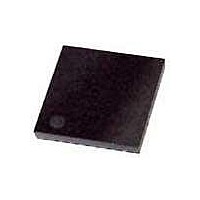WM9713LGEFL/RV Wolfson Microelectronics, WM9713LGEFL/RV Datasheet - Page 83

WM9713LGEFL/RV
Manufacturer Part Number
WM9713LGEFL/RV
Description
Audio CODECs Stereo AC'97 CODEC T/P Interface
Manufacturer
Wolfson Microelectronics
Datasheet
1.WM9713LGEFLRV.pdf
(132 pages)
Specifications of WM9713LGEFL/RV
Number Of Adc Inputs
1
Number Of Dac Outputs
1
Conversion Rate
8 KSPs
Interface Type
AC97
Resolution
12 bit
Maximum Operating Temperature
+ 85 C
Mounting Style
SMD/SMT
Package / Case
QFN-48
Minimum Operating Temperature
- 25 C
Number Of Channels
1 ADC, 1 DAC
Lead Free Status / RoHS Status
Lead free / RoHS Compliant
Available stocks
Company
Part Number
Manufacturer
Quantity
Price
Part Number:
WM9713LGEFL/RV
Manufacturer:
WOLFSON
Quantity:
20 000
Pre-Production
GPIO AND INTERRUPT CONTROL
w
The WM9713L has eight GPIO pins that operate as defined in the AC’97 Revision 2.2 specification.
Each GPIO pin can be set up as an input or as an output, and has corresponding bits in register 54h
and in slot 12. The state of a GPIO output is determined by sending data through slot 12 of outgoing
frames (SDATAOUT). Data can be returned from a GPIO input by reading the register bit, or
examining slot 12 of incoming frames (SDATAIN). GPIO inputs can be made sticky, and can be
programmed to generate an interrupt, transmitted either through the AC-Link or through a dedicated,
level-mode interrupt pin (GPIO2/IRQ, pin 45).
In addition, the GPIO pins 1, 3, 4 and 5 can be used for the PCM interface by setting bit 15 of
register 36h (see “PCM Codec” section). Setting this bit disables any GPIO functions selected on
these pins.
Table 60 GPIO Additional Function Control
GPIO pins 2 to 8 are multi-purpose pins that can also be used for other (non-GPIO / -PCM)
purposes, e.g. as a S/PDIF output or to signal pendown. This is controlled by register 56h (see Table
63)
Note that GPIO6/7/8 each have an additional function independent of the GPIO / auxiliary functions
discussed above. If these pins are to be used as GPIO then the independent function needs to be
disabled using its own control registers, e.g. to use pin 11 as a GPIO then the RESETB function
needs to be disabled (RSTDIS, register 5Ah, bit 8).
Independently of the GPIO pins, the WM9713L also has seven virtual GPIOs. These are signals from
inside the WM9713L, which are treated as if they were GPIO input signals. From a software
perspective, virtual GPIOs are the same as GPIO pins, but they cannot be set up as outputs, and are
not tied to an actual pin. This allows for simple, uniform processing of different types of signals that
may generate interrupts (e.g. pen down, battery warnings, jack insertion, high-temperature warning,
or GPIO signals).
36h
PCM Codec
Control
56h
GPIO Pin
Sharing
REGISTER
ADDRESS
15
8:2
BIT
CTRL
GEn
LABEL
0
1 (GPIO)
DEFAULT
GPIO Pin Configuration Control
0 = GPIO pins used as GPIOs
1 = GPIO pins used as PCM interface
Note: For PCM interface, one or more of these
pins (depending on master/slave/partial master
mode) must be set up as an output by writing to
register 4Ch (see Table 62)
Toggle GPIO pin function
0: secondary function enabled
1: GPIO enabled
DESCRIPTION
PP Rev 3.2 September 2008
WM9713L
83













